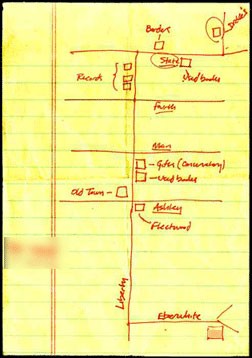 We’ve been in Santa Fe about 6 weeks now, and I’m getting lost (or at least turned around) less and less every day. In giving directions to our place over the phone, we’ve found the biggest issue is the pronunciation of the street names — how do you say, for instance, “Callecita”? The “ll” is pronounced “y” by some, and “ll” by others. The other one is “Cordova”—is the second “o” a long “o” sound or a sort of “u” sound, is the first syllable stressed or the second? (Answer: stress the first syllable, pronounce the second “o” as the “u” in “must.”)
We’ve been in Santa Fe about 6 weeks now, and I’m getting lost (or at least turned around) less and less every day. In giving directions to our place over the phone, we’ve found the biggest issue is the pronunciation of the street names — how do you say, for instance, “Callecita”? The “ll” is pronounced “y” by some, and “ll” by others. The other one is “Cordova”—is the second “o” a long “o” sound or a sort of “u” sound, is the first syllable stressed or the second? (Answer: stress the first syllable, pronounce the second “o” as the “u” in “must.”)
![]() Over on Slate there’s been a series on signs, subtitled “how they tell us where to go.” Recently there was a post entitled Do You Draw Good Maps?, about Paul Stiff, a reader in typography and graphic communication at the University of Reading in the United Kingdom, and who’s been looking at hand-drawn maps for three decades. (Like the one to the left.)
Over on Slate there’s been a series on signs, subtitled “how they tell us where to go.” Recently there was a post entitled Do You Draw Good Maps?, about Paul Stiff, a reader in typography and graphic communication at the University of Reading in the United Kingdom, and who’s been looking at hand-drawn maps for three decades. (Like the one to the left.)
Stiff believes that we amateurs have something to teach the pros. Our maps are efficient—they edit out unnecessary information. They often include what Stiff calls “an error detector, something that tells you something’s gone wrong.” (If you see the red barn, you’ve gone too far.) They adhere not to mapmaking norms but to the user’s particular needs.
Check out the post here, as well as the rest of the series.

At my old job we had a lot of temporary employees. Most of them were commuting out of DC into Rockville, a scary unfamiliar suburb. So whenever a new person came on board, I gave them a copy of the Food Map. I created a map of about 40 places to eat that were near enough to our office to drive there and back during a 1 hour lunch break.